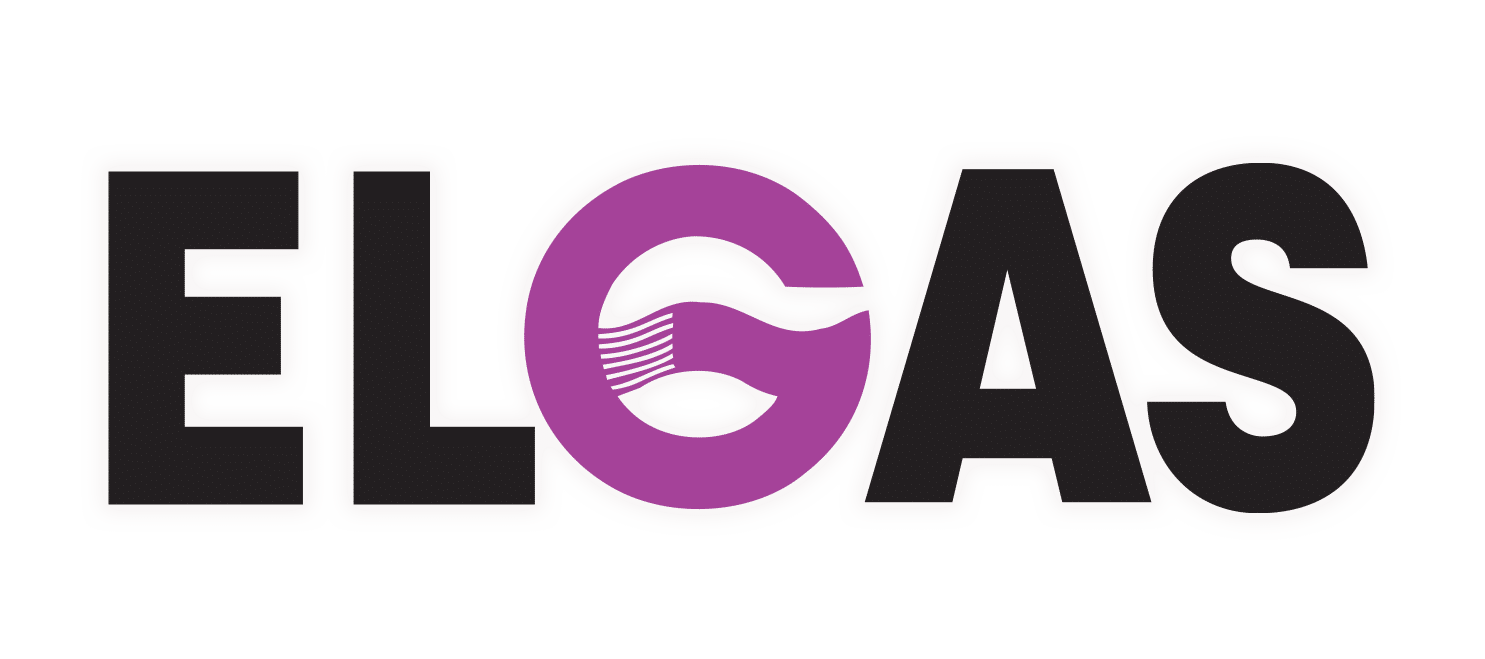LCC27 Gas Bottle Connections: POL to LCC27 Adaptor – Gas Bottle Adapter (LCC27 adaptor)
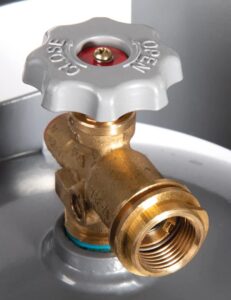 POL and LCC27 gas bottle connections (new gas bottle fittings) have the LCC27 new gas bottle connection (gas bottle fittings) that replaces the older POL gas bottle connections.
POL and LCC27 gas bottle connections (new gas bottle fittings) have the LCC27 new gas bottle connection (gas bottle fittings) that replaces the older POL gas bottle connections.
The LCC27 valve new gas bottle connection (new gas bottle connections) is also referred to as LCC27 new gas bottle fittings.
The LCC27 gas bottles, with LCC27 gas bottle fittings (LCC27 valve), have new safety features and are also backwards compatible, because they accepts both the POL and LCC27 new gas bottle connection for POL and LCC27 new gas bottle fittings.
It is important NOT to use a gas bottle adapter (LCC27 adaptor) to make this new gas bottle connection (gas bottle fittings).
These POL and LCC27 gas bottle connections (new gas bottle fittings) only affect BBQ gas bottle sizes in Australia.
The LCC27 gas bottle connections (new gas bottle connection) do not affect the 45kg POL and larger gas bottle connections nor commercial gas bottle sizes with POL gas bottle connections (gas bottle fittings).
The older POL gas bottle connections (gas bottle fittings) are found on a POL gas cylinder, POL gas hose, gas regulator with POL and various gas bottle fittings may include an LCC27 gas bottle adapter. However, a gas bottle adapter should not be used to make the new gas bottle connection.
POL gas bottle connections (gas bottle fittings) were previously found on gas bottles ranging from small BBQ bottles to large commercial gas bottle fittings.
The LCC27 valve with LCC27 new gas bottle connection (new gas bottle fittings) is the safer replacement for POL gas bottle fittings.
IMPORTANT SAFETY NOTE: Do not try to insert an LCC27 regulator into an older POL gas bottle.
Why the Change from POL to LCC27 Gas Bottle Valve for BBQ Gas Bottles
The reason for the change from the old POL gas bottle valve (Type 21) to the new LCC27 gas bottle valve was based on an unacceptable rate of BBQ fires and injuries, as evaluated by the authorities.
Further to this, the actual connection between the BBQ regulator and the POL gas bottle valve was determined to be the major problem, as they could develops gas leaks too easily.
The new LCC27 gas bottle valve has a new built-in safety device, a backcheck valve, that prevents the gas from coming out unless the new gas bottle connection is properly done, preventing leaks and fires.
There is also a thermal cut-off designed into the new appliance connection to stop the gas flow in the event of a fire.
Timeline for the Change from POL to LCC27 Gas Bottle Valve
- 1 April 2021: Gas bottle (gas cylinder) suppliers were required to change over from the POL valve (Type 21) to the LCC27 valve for all BBQ gas bottle sizes in Australia.
- 1 April 2022: The manufacturers of BBQs, patio heaters and other outdoor gas appliances changed to the new LCC27 gas fittings.
- 2032: Target date to have all old POL BBQ gas bottles removed from circulation.
The one-year head start on the change for the gas bottles was to make sure that there were sufficient LCC27 gas bottles in circulation prior to the appliance changeover.
The ten-year timeline is based on the ten-year expiry for BBQ size gas bottles.
Statistically, each year 1/10th of the BBQ gas bottle population will require an inspection, at which time the old POL valve is removed and a new LCC27 valve is fitted.
By 2032 the last of the old POL gas bottles will have required an inspection and the last of the POL valves removed.
NOTE: This change only applies to BBQ size gas bottles and not 45kg and larger gas bottles.
Difference Between POL and LCC27 Gas Bottle Fittings
In summary:
- The new LCC27 gas bottle valve has a new built-in safety device, a backcheck valve, that prevents the gas from coming out unless the new gas bottle connection is properly done, preventing leaks and fires.
- There is also a thermal cut-off designed into the new appliance connection to stop the gas flow in the event of a fire.
- POL and LCC27 gas bottle connections (new gas bottle connection) are very different, however, both the POL and LCC27 gas bottle are still available from SWAP’n’GO.
- POL gas bottle connections are the most common type of valve & gas fittings, in Australia, for 4kg to 210kg gas bottles, including 45kg gas bottles.
- The LCC27 valve with LCC27 new gas bottle connection (new gas bottle fittings) are the new gas bottle connection for BBQ size gas bottles.
- The POL gas bottle connections (gas bottle fittings) on BBQ size gas bottles (9kg gas bottle & 4kg gas bottle) are being replaced by the LCC27 new gas bottle connection (LCC27 valve).
- POL refers to a type of valves and gas bottles that have POL gas bottle connections (gas bottle fittings).
- “POL” is an acronym for the company that first made the POL gas bottle fittings (gas bottle connections) — Prest-O-Lite.
- POL gas bottle connections on gas bottle fittings refers to the main valve.
- The POL gas bottle connections (gas bottle fittings) are notable for the reverse — left-handed — thread.
- LCC27 new gas bottle connection (new gas bottle connections) have a normal right-handed thread and the LCC27 gas bottles (LCC27 valve) are backwards compatible with POL regulators.
- A pressure relief valve is incorporated within both the POL and LCC27 gas bottles, for safety.
You should also be aware of a few more features on both the POL and LCC27 gas bottle connections (new gas bottle connection)…
LCC27 to POL Adaptor (POL to LCC27 Adaptor): Gas Bottle Adapter (LCC27 adaptor) Use… Just Don’t
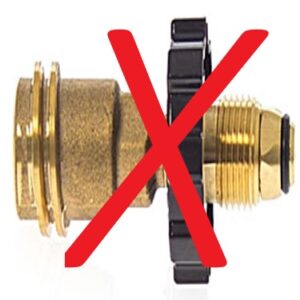 Don’t use a gas bottle adapter (LCC27 adaptor), with a LCC27 to POL new gas bottle connection, to connect a gas bottle with POL gas bottle connections (gas bottle fittings) to LPG gas appliances that have an LCC27 new gas bottle connection (new gas bottle connections). It is both unsafe and illegal.
Don’t use a gas bottle adapter (LCC27 adaptor), with a LCC27 to POL new gas bottle connection, to connect a gas bottle with POL gas bottle connections (gas bottle fittings) to LPG gas appliances that have an LCC27 new gas bottle connection (new gas bottle connections). It is both unsafe and illegal.
Whilst you may have purchased an LCC27 to POL adaptor (POL to LCC27 adaptor) (gas bottle adapter), creating an adapter gas bottle (LCC27 adaptor), at Bunnings or other BBQ store, please remove and discard any LCC27 to POL adaptor (POL to LCC27 adaptor) because it is a safety hazard.
Exchange your POL gas bottles for LCC27 gas bottle (LCC27 valve), with the new gas bottle connection (gas bottle fittings), at the same SWAP’n’GO prices.
It is dangerous and illegal to use an adapter gas bottle (LCC27 adaptor) with a LCC27 to POL adaptor (POL to LCC27 adaptor) (gas bottle adapter) because the POL and LCC27 gas bottle connections (new gas bottle connection) have different thread directions, so as you tighten one of the gas bottle connections, you can actually loosen the other gas bottle adapter gas bottle connections, potentially leading to a gas leak and the risk of cold burns or fire.
In addition, LCC27 adaptors (LCC27 to POL adaptor or POL to LCC27 adaptor) are banned in in all States. WA, QLD, VIC, TAS, NT and SA state governments have posted warnings against LCC27 adaptor use. This follows a homeowner receiving severe burns resulting from a gas cylinder fire in Western Australia whilst using an LCC27 to POL adaptor (POL to LCC27 adaptor) (gas bottle adapter). The injured person was hospitalised for further treatment.
Swapping a POL Gas Bottle for LCC27 Gas Bottle
As mentioned, SWAP’n’GO® lets you swap an older POL gas bottles for newer LCC27 gas bottle (LCC27 valve), with new gas bottle connection (gas bottle fittings), at the same SWAP’n’GO prices.
So, if you purchase a BBQ with the LCC27 new gas bottle connections (new gas bottle connection) but have an old bottle with POL gas bottle connections, you just need to swap.
You will find both POL and LCC27 gas bottle in the SWAP’n’GO cages during the transition period, which will stretch over a number of years.
Remember, LCC27 valve with LCC27 gas bottle connections (new gas bottle connection) is backwards compatible with POL regulators.
POL Gas Bottle Fittings and LCC27 New Gas Bottle Connection (gas bottle fittings)
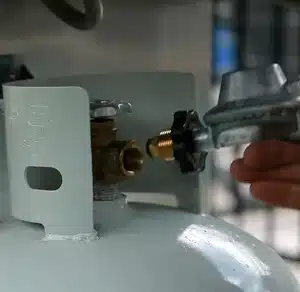
POL gas bottle fittings have LPG gas fittings and connections used on a range of LPG gas bottles whilst LCC27 new gas bottle connection (gas bottle fittings) is only on BBQ gas bottle sizes.
The female POL gas bottle fittings are incorporated into the POL valve fitting on the LPG gas bottle, utilising a left-handed or reverse thread whereas LCC27 new gas bottle connection has a normal right-handed thread.
The male POL gas bottle fittings are used on pigtail connectors, BBQ gas regulators and other hose style gas bottle fittings.
LCC27 gas bottle (LCC27 valve) typically only connects to BBQ size gas regulators, including outdoor gas heaters and other outdoor gas appliances.
At one time, the POL gas bottle fittings were used in many countries, including the USA, but it has faded in popularity.
Currently, Australia is the most notable POL gas bottle fittings user.
The LCC27 gas bottle (LCC27 valve) is unique to Australia.
The following chart shows the acceptable and unacceptable gas bottle fittings involving POL and LCC27 gas bottle fittings with POL and LCC27 new gas bottle connection (gas bottle fittings).
IMPORTANT SAFETY NOTE: Do not try to insert an LCC27 regulator into an older POL gas bottle.

LCC27 Gas Bottles (LCC27 Gas Bottle Fittings) with LCC27 New Gas Bottle Connection
All outdoor gas appliances sold after 1 April 2022 must have LCC27 gas fittings and will only work with LCC27 gas bottles.
The LCC27 gas bottle with LCC27 new gas bottle connection (gas bottle fittings) is replacing the POL gas bottle fittings because BBQ regulators now have the LCC27 new gas bottle fittings with LCC27 new gas bottle connection.
The LCC27 new gas bottle connection (LCC27 valve) is a safety improvement over the older POL gas bottle connections (gas bottle fittings).
No gas will come out of a LCC27 gas bottle (LCC27 new gas bottle connection) unless a regulator is properly screwed in.
With the older POL gas bottle connections (gas bottle fittings), gas will come out of the gas bottle even if nothing is screwed in.
LCC27 new gas bottle connection (LCC27 valve) is reverse compatible with POL gas bottle connections (gas bottle fittings), as shown in the image above.
In other words, both a POL and LCC27 regulator will screw onto an LCC27 gas bottle (LCC27 new gas bottle connection).
However, only a POL regulator will screw into a POL gas bottle.
OPD Valves for Propane Tanks – Propane Tank Overfill Valve
An OPD gas bottle connections (gas bottle fittings) have an OPD cylinder valve. OPD is the acronym for “Overfill Protection Device” or “Overfilling Prevention Device”.
OPD gas bottle connections (gas bottle fittings) are best described as a propane tank overfill valve.
As the name suggests, an OPD gas bottle connections (gas bottle fittings) have a protective mechanism, that prevents propane tank overfill, built into the valve.
OPD valves are used in the USA, instead of POL gas bottle connections (gas bottle fittings).
Gas Regulator Gas Pressure
A gas regulator controls the regulator gas pressure at which the LPG is delivered from the gas bottle.
BBQ gas regulators typically come equipped with an attached gas hose.
The gas regulator screws directly into the gas bottle connections (gas bottle fittings) whilst the gas hose is attached to the BBQ.
The standard BBQ regulator type in Australia, since 2022, is a regulator with LCC27 gas bottle connections (gas bottle fittings).
The new regulator has a female LCC27 gas bottle connections (gas bottle fittings), with a right-handed thread, that fits male gas bottle fittings on the LCC27 gas bottle (LCC27 valve).
Older BBQs and BBQ gas bottles have POL gas bottle fittings.
POL Gas Bottle Connections (gas bottle fittings) Continue on 45kg Gas Bottles and Larger
 Unlike the LCC27 gas bottles for BBQs, the LCC27 new gas bottle connection (new gas bottle fittings) do not apply to the larger residential gas bottles.
Unlike the LCC27 gas bottles for BBQs, the LCC27 new gas bottle connection (new gas bottle fittings) do not apply to the larger residential gas bottles.
On home gas bottles, like a 45kg gas bottle, the gas line pigtail have POL gas bottle connections that screws into the large female threaded gas bottle connections (gas bottle fittings) on the side of the valve.
So, home gas bottles have NOT switched to the LCC27 new gas bottle connection (gas bottle fittings).
POL gas bottle connections (gas bottle fittings) are unique in that it has a left-handed or reverse thread gas bottle fittings.
So, to tighten a POL gas bottle fittings, you turn the connector anti-clockwise.
Tightening of pigtail gas bottle fittings is done with a wrench.
You should always do a soapy water leak test after every POL gas bottle connections (gas bottle fittings) reconnection.
Gas Bottle Connections Seal on POL Gas Bottle Fittings
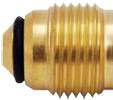 The POL gas bottle connections (gas bottle fittings) were originally designed as a metal-to-metal compression seal gas bottle fittings.
The POL gas bottle connections (gas bottle fittings) were originally designed as a metal-to-metal compression seal gas bottle fittings.
Pigtail gas bottle fittings still use metal-to metal-connections.
However, some BBQ POL gas bottle connections (gas bottle fittings) are now manufactured with rubber O-rings because they further improve the gas bottle connections seal.
The downside is that these gas bottle fittings can become damaged or deteriorate over time so they should be checked regularly.
Gas Valve Hand Wheel on POL and LCC27 Gas Bottle
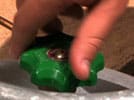 Located on the top of the POL and LCC27 gas bottle (LCC27 valve), the gas valve hand wheel controls the flow of gas, once the gas bottle fittings (gas fittings) are secure.
Located on the top of the POL and LCC27 gas bottle (LCC27 valve), the gas valve hand wheel controls the flow of gas, once the gas bottle fittings (gas fittings) are secure.
There is no difference between gas valve hand wheels on POL and LLC27 gas bottle (LCC27 valve).
Turning the hand wheel anti-clockwise starts the flow of gas but you should avoid turning it hard to the open stop.
Opening the valve 2 or 3 turns is all you need.
You shut the gas off by turning the hand wheel clockwise, tightening firmly by hand only.
CAUTION: Never open the valve when unattached
Bleed Screw on POL and LCC27 Gas Bottle
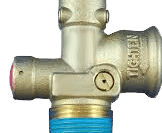 The POL and LCC27 gas bottle (LCC27 valve) are both equipped with a bleed screw for decant filling because it is required when having a BBQ bottle filled at a service station.
The POL and LCC27 gas bottle (LCC27 valve) are both equipped with a bleed screw for decant filling because it is required when having a BBQ bottle filled at a service station.
It is a small slotted screw on the side of the valve.
The filling technician opens the screw during filling to determine proper filling.
On the other hand, most large gas depots fill cylinders by weight, on digital scales, so the bleed screw is not used.
There is no difference between bleed screws on the POL and LLC27 gas bottle (LCC27 valve).
CAUTION: Never open the bleed screw on your gas valve
Dip Tube on POL and LCC27 Gas Bottle
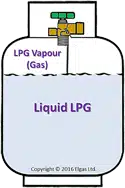 POL and LCC27 gas bottle (LCC27 valve) have a tube that sticks down into the cylinder, called a ‘dip tube’.
POL and LCC27 gas bottle (LCC27 valve) have a tube that sticks down into the cylinder, called a ‘dip tube’.
It extends down to the bottom of the ullage area (see image).
Ullage is the 20% unfilled space at the top of the gas cylinder that allows for expansion of the gas.
This dip tube is connected to the bleed screw and lets the filling technician know when the cylinder is filled up to the ullage zone, because it starts venting a white cloud of gas
There is no difference between dip tubes on the POL and LLC27 gas bottle (LCC27 valve).
Pressure Relief Valve on POL and LCC27 Gas Bottle
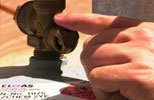 The pressure relief valve is the single most critical gas bottle fittings safety feature on an LPG cylinder.
The pressure relief valve is the single most critical gas bottle fittings safety feature on an LPG cylinder.
It is incorporated within the POL and LCC27 gas bottle valves and appears as the protrusion opposite the main connection. (See image)
It usually incorporates some kind of plastic dust cover that should be left in place.
Pressure relief valves are designed to relieve excess pressure that might result from overfilling or exposure to excessive heat or fire.
The function of a pressure relief valve is to keep a cylinder from rupturing in the unlikely event of excessive pressure build-up.
The pressure relief valves are held in the closed position by the force of a powerful spring inside.
As long as the pressure is less than that of the spring no gas will vent since the valve will remain closed.
There is no difference between pressure relief valves on the POL and LLC27 gas bottle (LCC27 valve).
Gas Venting on POL and LCC27 Gas Bottle
 Having the pressure relief valve releasing gas is a rare event.
Having the pressure relief valve releasing gas is a rare event.
Most people will never experience venting.
If the pressure rises beyond the force of the spring, the valve will open to vent the excess pressure.
You may hear a hissing sound and see cold white gas vapour being released because the pressure relief valve has been activated.
Once sufficient pressure is released, the valve stops releasing gas since the spring pressure can push the valve closed.
If this ever happens, just stay clear of the area and let the gas dissipate.
IMPORTANT: The pressure relief valve must be pointed safely away from combustible materials.
You should also call your LPG supplier, from a safe location because you should advise them that your gas cylinder is venting gas.
Do not use your mobile phone, any electrical devices or other ignition sources near a venting gas cylinder.
There is no difference between possible gas venting on the POL and LLC27 gas bottle (LCC27 valve).
Newer BBQs Incorporate New Gas Bottle Connection for LCC27 Gas Bottle
A BBQ gas regulator and hose usually come as an assembly but hoses are also sold separately.
BBQ gas regulators with the new gas bottle connection (new gas bottle fittings) for the LCC27 gas bottle (LCC27 valve) incorporate the LCC27 new gas bottle fittings and involve less components than home installations because the BBQ gas bottle fittings are just the gas regulator and hose compilation.
BBQ Gas Leak Test
It is important to regularly leak test your BBQ gas fittings (gas bottle fittings), gas regulator and hose.
Leaks from these items are frequently the cause of BBQ gas fires.
How to Test POL and LCC27 Gas Bottle Fittings
This test works on both the POL and LCC27 new gas bottle connections and new gas bottle fittings.
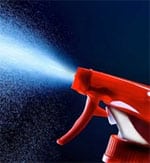 Put some soapy water in a spray bottle.
Put some soapy water in a spray bottle.
Turn on the gas bottle without turning on the BBQ.
Next, spray the entire gas bottle connections (gas bottle fittings) including the valve, gas regulator and hose assembly with the soapy water.
Bubbles will form if there is a gas leak and you may also smell the gas.
When done, rinse gas bottle fittings with clean water to remove the soap solution.
For more details, please see: BBQ Gas Leak Test
Hot To Safely Attach or Change Your on POL and LCC27 Gas Bottle
Connecting & Disconnecting Your Gas Regulator with POL and LCC27 New Gas Bottle Connections (new gas bottle fittings)
IMPORTANT SAFETY NOTE: Do not try to insert an LCC27 regulator into an older POL gas bottle.
An LCC27 new gas bottle connection has the LCC27 regulator with female new gas bottle fittings that screws onto the male LCC27 new gas bottle connection (new gas bottle fittings).
The LCC27 new gas bottle connection (new gas bottle fittings) have a normal right-handed thread.
The male connector of a gas regulator, with a POL gas bottle connections (gas bottle fittings), has a reverse or left-handed thread. (POL shown in image)
So, to detach, you turn the POL gas bottle fitting (gas bottle fittings) clockwise and then anti-clockwise to re-attach.
Full step-by-step instructions:
New Residential LPG customer?
New Business LPG customer?
Existing ELGAS customer?
Steve Reynolds
Technical Consultant
Steve Reynolds is a leading expert in the LPG industry with over 22 years of experience. As part of the national management team at ELGAS, Steve ensures the safe and efficient storage, handling, and transportation of LPG. He serves as the lead investigator for incidents and collaborates with authorities on industry developments.
Steve is a technical advisor to Standards Australia and Gas Energy Australia (GEA), and an active member of the World LPG Association (WLPGA), contributing to global standards and technical reviews. He holds a BSc. (Hons) in Industrial Chemistry from UNSW and has held senior safety and technical roles at ELGAS, making him a trusted authority in LPG safety and standards.
